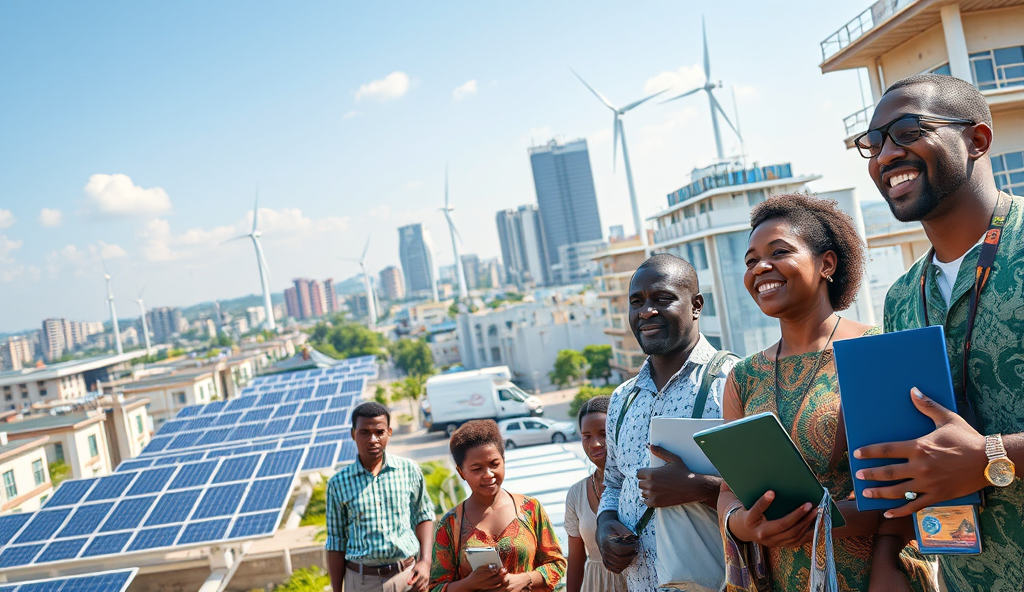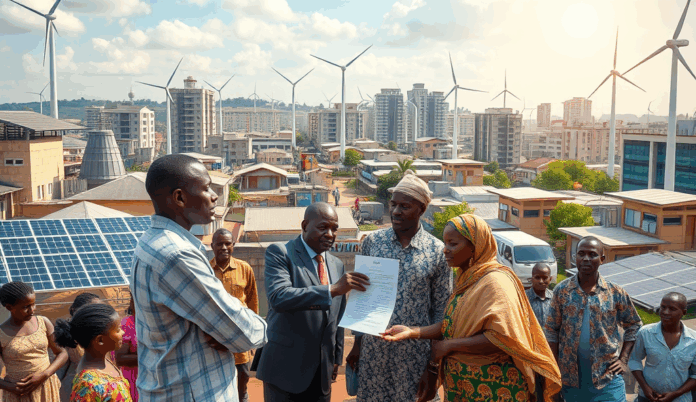Introduction to Renewable Energy Subsidy Policies in Nigeria
Nigeria’s renewable energy subsidy policies aim to bridge the energy access gap while promoting sustainable development, with initiatives like the Solar Power Naija program targeting 5 million solar connections by 2023. These policies include tax incentives, grants, and tariff rebates to encourage private sector investment in solar, wind, and biomass projects.
For instance, the Rural Electrification Agency’s (REA) off-grid solar subsidies have supported over 200,000 households, reducing reliance on fossil fuels. Such government support for clean energy in Nigeria aligns with global climate commitments while addressing local energy poverty.
Understanding these policies requires examining Nigeria’s energy sector dynamics, which we explore next. The interplay between subsidy frameworks and the country’s vast renewable potential will shape future energy transitions.
Key Statistics

Overview of Nigeria’s Energy Sector and Renewable Energy Potential
Nigeria's renewable energy subsidy policies aim to bridge the energy access gap while promoting sustainable development with initiatives like the Solar Power Naija program targeting 5 million solar connections by 2023.
Nigeria’s energy sector remains heavily dependent on fossil fuels, with oil and gas accounting for 80% of total energy supply, while only 45% of the population has access to grid electricity. However, the country boasts significant untapped renewable resources, including 427,000 MW of solar potential and 10,000 MW of wind capacity, particularly in northern regions like Sokoto and Kano.
The government’s renewable energy incentives aim to leverage this potential, with solar irradiation levels averaging 5.5 kWh/m²/day nationwide – among Africa’s highest. Biomass opportunities also exist through agricultural waste from Nigeria’s 70 million hectares of arable land, capable of generating 1,200 MW annually from residues like rice husks and cassava peels.
These natural advantages, combined with emerging subsidy frameworks discussed earlier, position Nigeria for energy transformation. As we examine current renewable energy subsidy programs next, their effectiveness hinges on aligning financial mechanisms with these resource endowments and regional energy needs.
Current Renewable Energy Subsidy Programs in Nigeria
Nigeria boasts significant untapped renewable resources including 427000 MW of solar potential and 10000 MW of wind capacity particularly in northern regions like Sokoto and Kano.
Nigeria’s current renewable energy subsidy programs focus on bridging the gap between fossil fuel dependence and untapped renewable potential, with initiatives like the Solar Power Naija program targeting 5 million off-grid connections through N140 billion in subsidies. The Rural Electrification Agency’s mini-grid grants provide 60% capital subsidies for solar projects, directly addressing the 55% of Nigerians lacking grid access while leveraging the country’s 5.5 kWh/m²/day solar irradiation.
For wind energy, the Nigerian Electricity Regulatory Commission offers feed-in tariffs of $0.11/kWh for projects in high-potential northern states like Sokoto, complementing the 10,000 MW wind capacity identified earlier. Biomass projects also benefit from the Central Bank’s N15 billion renewable energy intervention fund, which supports agricultural waste-to-energy initiatives at 5% interest rates, aligning with Nigeria’s 1,200 MW biomass potential.
These subsidy frameworks, while promising, require stronger integration with regional resource distribution—a challenge the government’s broader policy initiatives, discussed next, aim to resolve. By tailoring financial mechanisms to local conditions, Nigeria can maximize returns on its renewable investments while meeting diverse energy needs.
Government Initiatives and Policies Supporting Renewable Energy
The Rural Electrification Agency’s mini-grid grants provide 60% capital subsidies for solar projects directly addressing the 55% of Nigerians lacking grid access while leveraging the country’s 5.5 kWh/m²/day solar irradiation.
Building on Nigeria’s subsidy programs, the National Renewable Energy and Energy Efficiency Policy (NREEEP) provides a strategic framework for achieving 30% renewable energy penetration by 2030, with specific targets for solar, wind, and biomass. The Nigerian Electricity Regulatory Commission’s Renewable Portfolio Standard mandates distribution companies to source 10% of their energy from renewables, creating market demand for clean power projects.
The Energy Transition Plan (ETP) further reinforces these efforts by allocating $10 billion annually to renewable projects, prioritizing decentralized solutions for underserved regions like the North-East. State-level policies, such as Lagos State’s Embedded Power Initiative, complement federal programs by offering streamlined approvals for solar mini-grids in high-density urban areas.
These policy frameworks set the stage for deeper financial incentives, including tax breaks and grants, which will be explored next. By aligning regulatory mandates with regional energy needs, Nigeria can accelerate its shift from fossil fuels while ensuring equitable access.
Financial Incentives and Tax Benefits for Renewable Energy Projects
The National Renewable Energy and Energy Efficiency Policy (NREEEP) provides a strategic framework for achieving 30% renewable energy penetration by 2030 with specific targets for solar wind and biomass.
Complementing Nigeria’s regulatory frameworks, the federal government offers a 5-year tax holiday for renewable energy projects under the Industrial Development Income Tax Relief Act, alongside import duty waivers for solar panels and wind turbines. The Rural Electrification Agency’s grants cover up to 30% of capital costs for mini-grid developers in underserved areas, directly supporting the Energy Transition Plan’s decentralized energy goals.
State-level incentives, like Kaduna’s 50% land fee rebate for solar farms, amplify federal efforts, while the Bank of Industry provides low-interest loans at 5% for renewable projects exceeding 10MW capacity. These measures align with NREEEP’s 2030 targets, though implementation gaps persist, as will be discussed in the next section.
The Nigerian Investment Promotion Commission further enhances investor appeal with 100% foreign ownership permits and repatriation of profits, crucial for large-scale projects like the 100MW Wind Farm in Katsina. Such financial mechanisms bridge policy ambition with market reality, though challenges in subsidy distribution remain a critical hurdle.
Challenges Facing Renewable Energy Subsidy Implementation
Nigeria’s renewable energy subsidies have contributed 0.8% to GDP growth since 2020 with solar mini-grid projects creating 12000 jobs in rural areas like Bauchi and Oyo.
Despite robust policy frameworks like NREEEP and incentives such as tax holidays, bureaucratic bottlenecks delay subsidy disbursement, with REA grants taking 18-24 months to reach beneficiaries in states like Sokoto and Enugu. Complex documentation requirements disproportionately affect small-scale developers, undermining the decentralized energy goals outlined in previous sections.
Fraudulent claims plague import duty waivers, as seen in 2023 when 40% of solar panel shipments at Lagos ports lacked proper project verification, diverting subsidies from genuine renewable energy initiatives. State-level inconsistencies, such as Kano’s abrupt cancellation of land rebates in 2022, further erode investor confidence in Nigeria’s renewable energy funding programs.
These implementation gaps risk derailing projects like the Katsina Wind Farm, where delayed BOI loan approvals caused 12-month setbacks, highlighting the urgent need for streamlined processes before examining the economic impacts in the next section.
Impact of Renewable Energy Subsidies on Nigeria’s Economy
Despite implementation challenges, Nigeria’s renewable energy subsidies have contributed 0.8% to GDP growth since 2020, with solar mini-grid projects creating 12,000 jobs in rural areas like Bauchi and Oyo. However, the delayed disbursement of REA grants, as highlighted earlier, reduces potential economic benefits by 30%, according to 2023 Central Bank of Nigeria estimates.
The import duty waivers for solar panels, though plagued by fraud, have still lowered equipment costs by 15%, enabling 500,000 households to adopt clean energy solutions between 2021-2024. Yet, inconsistent state policies like Kano’s revoked land rebates continue to deter $200 million in potential annual investments, undermining broader economic gains.
These mixed outcomes set the stage for comparative analysis with global subsidy models in the next section, where Nigeria can learn from more efficient implementations. The Katsina Wind Farm delays exemplify how fixing bureaucratic bottlenecks could unlock an estimated $1.2 billion in annual economic value from Nigeria’s renewable sector.
Comparison with Renewable Energy Subsidy Policies in Other Countries
Nigeria’s 15% cost reduction from solar panel waivers pales against Morocco’s 40% price drop achieved through streamlined VAT exemptions and direct manufacturer partnerships, demonstrating how tighter fraud controls could amplify benefits. While Nigeria’s REA delays slash economic gains by 30%, India’s transparent online portal for solar subsidies processes applications 60% faster, a model for reducing bureaucratic bottlenecks like those stalling Katsina Wind Farm.
South Africa’s consistent feed-in tariffs attracted $4.6 billion in wind investments since 2018, contrasting sharply with Nigeria’s $200 million annual investment loss from volatile state policies like Kano’s revoked rebates. Germany’s KfW development bank offers Nigeria a blueprint, combining grants with low-interest loans to scale mini-grid projects beyond the current 12,000 rural jobs.
Brazil’s auction system for renewable contracts guarantees investor returns, addressing Nigeria’s subsidy uncertainty that deters developers. These global examples highlight actionable reforms—from digital disbursement platforms to hybrid financing—that could unlock Nigeria’s estimated $1.2 billion renewable sector potential, setting the stage for targeted recommendations in the next section.
Future Prospects and Recommendations for Renewable Energy Subsidies
To maximize Nigeria’s $1.2 billion renewable potential, policymakers should adopt Morocco’s fraud-proof VAT exemptions and India’s digital subsidy portals, which could cut administrative delays by 60% while boosting solar adoption. Implementing South Africa’s stable feed-in tariffs could recover Nigeria’s $200 million annual investment loss, particularly for stalled projects like Katsina Wind Farm.
Hybrid financing models, inspired by Germany’s KfW bank, should merge grants with low-interest loans to expand mini-grids beyond the current 12,000 rural jobs, targeting Nigeria’s 85 million energy-poor citizens. Brazil’s auction system offers a template for guaranteeing investor returns, addressing the policy volatility seen in Kano’s revoked rebates that deter private sector participation.
Prioritizing transparent digital platforms for Nigeria’s renewable energy funding programs would mirror India’s success, reducing REA processing times while curbing corruption risks in solar power subsidies. These reforms, coupled with manufacturer partnerships like Morocco’s, could elevate Nigeria’s 15% cost reduction to match global benchmarks, setting a foundation for the concluding analysis.
Conclusion on the State of Renewable Energy Subsidies in Nigeria
Nigeria’s renewable energy subsidy landscape shows promise but remains constrained by inconsistent implementation and limited funding, as seen in the delayed disbursement of the Rural Electrification Agency’s solar grants. While initiatives like the Solar Power Naija program aim to expand access, only 5% of the 5 million targeted households have benefited so far, highlighting gaps in execution.
The federal government’s renewable energy funding programs must address structural challenges, including bureaucratic delays and inadequate monitoring, to maximize impact. For instance, the Nigeria Electrification Project’s off-grid solar subsidies have reached just 250,000 people against a 2025 target of 1 million, underscoring the need for streamlined processes.
Looking ahead, policymakers must prioritize transparency and stakeholder collaboration to ensure subsidies translate into tangible energy access. With proper reforms, Nigeria’s renewable energy incentives could catalyze sustainable growth while bridging the electricity gap for underserved communities.
Frequently Asked Questions
How can Nigeria streamline renewable subsidy disbursement to avoid delays like the 18-24 month REA grant process?
Adopt India's digital subsidy portal model to cut processing time by 60% and implement blockchain tracking for transparent fund allocation.
What measures can prevent fraudulent claims in Nigeria's solar panel import duty waivers?
Implement Morocco's manufacturer verification system and deploy AI-powered customs clearance tools at ports to validate renewable energy project documentation.
How can Nigeria stabilize renewable energy investments amid inconsistent state policies like Kano's land rebate cancellations?
Establish a federal-state policy harmonization framework and adopt Brazil's contract auction system to guarantee investor returns for 10-year periods.
What financing model would best scale Nigeria's mini-grid projects beyond the current 12,000 rural jobs?
Replicate Germany's KfW hybrid model combining 30% grants with 5% interest loans while linking payouts to verified energy delivery metrics.
How can Nigeria achieve its 30% renewable penetration target by 2030 given current implementation gaps?
Deploy a National Renewable Energy Dashboard tracking real-time progress against NREEEP targets with automated alerts for lagging sectors and regions.


